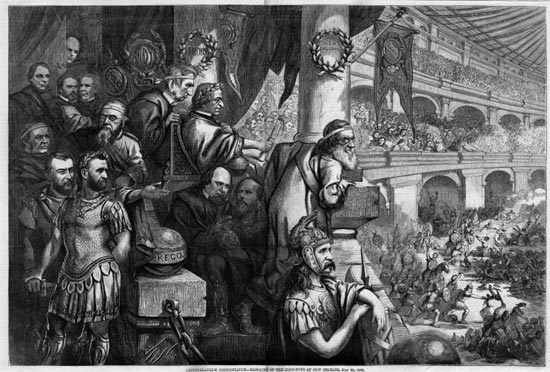Nast's Uncle Sam on the cover of Harper's Weekly (27 June 1874).
Thomas Nast was one of the most important and influential American editorial cartoonists and caricaturists of the 19th century, best known for his work for Harper's Weekly. The "Father of American Cartoons" was born in Landau, Germany, however, as the son of a trombonist in the Bavarian 9th regiment band. By 1846 the Nast family headed for New York City because of father Nast's political beliefs.
Nast attended the National Academy of Design, but he didn't have the discipline for school. He began his cartooning career with Frank Leslie's Illustrated Newspaper in 1856. He was one of the main contributors to Harper's Weekly between 1859 and 1896 with a production of about 2200 cartoons. Among his many covers and drawings were also several multi-panel spreads.
Regular themes in Nast's work were his attacks on those in power and the corrupt and his support for minorities. His work was of such influence that his biting drawings helped lead to the downfall of New York Democratic politician and member of the House of Representatives "Boss" Tweed in 1871.
Nast's cartoon on the Orange Riot of 12 July 1871 (Harper's, 29 July 1871).
Nast's cartoons were used as major election posters during the Lincoln-Johnson campaign in 1864, and played a key role in Lincoln's re-election. Abraham Lincoln reportedly called him the Union's best recruiter for his drawings during the Civil War. He is also responsible for the popular representations of iconic characters like Uncle Sam and Santa Claus, but also of Columbia, the Republican Party elephant and Tammany Hall tiger.
Nast had become more of a satirical cartoonist by the time Andrew Johnson became president in 1865, and the artist repeatedly depicted him as a Roman emperor. After his support of Democratic presidential candidate Grover Cleveland in 1884 he lost his popularity with the Republicans around age 44. He decreased his production for Harper's around 1896, and continued to contribute to other publications like the Illustrated American and his own Nast's Weekly, but with little success.
Nast had lost most of his savings in a Wall Street swindle and died of yellow fever in Guayaquil, Ecuador, where President Roosevelt had appointed him Consul General in 1902.
Thomas Nast remains a strong influence on many (political) cartoonists. He was an inspiration to Homer Davenport, Harvey Kurtzman, Gary Panter, Robert Crumb and Adam Zyglis.
'Amphitheatrum Johnsonian - Massacre of the Innocents at New Orleans' (Harper's, 30 July 1866).







